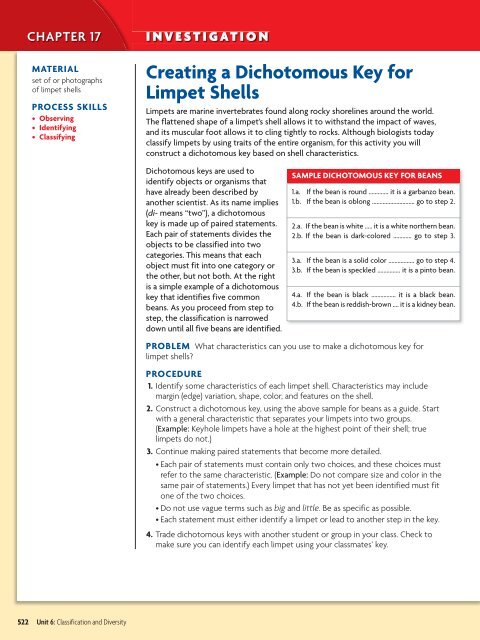Classification and Diversity
Classification and Diversity
Classification and Diversity
You also want an ePaper? Increase the reach of your titles
YUMPU automatically turns print PDFs into web optimized ePapers that Google loves.
CHAPTER 17<br />
MATERIAL<br />
set of or photographs<br />
of limpet shells<br />
PROCESS SKILLS<br />
• Observing<br />
• Identifying<br />
• Classifying<br />
INVESTIGATION<br />
Creating a Dichotomous Key for<br />
Limpet Shells<br />
Limpets are marine invertebrates found along rocky shorelines around the world.<br />
The flattened shape of a limpet’s shell allows it to withst<strong>and</strong> the impact of waves,<br />
<strong>and</strong> its muscular foot allows it to cling tightly to rocks. Although biologists today<br />
classify limpets by using traits of the entire organism, for this activity you will<br />
construct a dichotomous key based on shell characteristics.<br />
Dichotomous keys are used to<br />
identify objects or organisms that<br />
have already been described by<br />
another scientist. As its name implies<br />
(di- means “two”), a dichotomous<br />
key is made up of paired statements.<br />
Each pair of statements divides the<br />
objects to be classified into two<br />
categories. This means that each<br />
object must fit into one category or<br />
the other, but not both. At the right<br />
is a simple example of a dichotomous<br />
key that identifies five common<br />
beans. As you proceed from step to<br />
step, the classification is narrowed<br />
down until all five beans are identified.<br />
SAMPLE DICHOTOMOUS KEY FOR BEANS<br />
1.a. If the bean is round ............. it is a garbanzo bean.<br />
1.b. If the bean is oblong ............................ go to step 2.<br />
2.a. If the bean is white ..... it is a white northern bean.<br />
2.b. If the bean is dark-colored ............ go to step 3.<br />
3.a. If the bean is a solid color ................. go to step 4.<br />
3.b. If the bean is speckled …............ it is a pinto bean.<br />
4.a. If the bean is black …..........… it is a black bean.<br />
4.b. If the bean is reddish-brown …. it is a kidney bean.<br />
PROBLEM What characteristics can you use to make a dichotomous key for<br />
limpet shells?<br />
PROCEDURE<br />
1. Identify some characteristics of each limpet shell. Characteristics may include<br />
margin (edge) variation, shape, color, <strong>and</strong> features on the shell.<br />
2. Construct a dichotomous key, using the above sample for beans as a guide. Start<br />
with a general characteristic that separates your limpets into two groups.<br />
(Example: Keyhole limpets have a hole at the highest point of their shell; true<br />
limpets do not.)<br />
3. Continue making paired statements that become more detailed.<br />
• Each pair of statements must contain only two choices, <strong>and</strong> these choices must<br />
refer to the same characteristic. (Example: Do not compare size <strong>and</strong> color in the<br />
same pair of statements.) Every limpet that has not yet been identified must fit<br />
one of the two choices.<br />
• Do not use vague terms such as big <strong>and</strong> little. Be as specific as possible.<br />
• Each statement must either identify a limpet or lead to another step in the key.<br />
4. Trade dichotomous keys with another student or group in your class. Check to<br />
make sure you can identify each limpet using your classmates’ key.<br />
522 Unit 6: <strong>Classification</strong> <strong>and</strong> <strong>Diversity</strong>

















